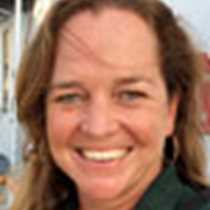Isabela and Fernandina Island
A spectacular sunrise took place behind the towering northern volcanoes of Isabela Island this morning, casting complicated shadows and plays of light and dark over the still waters of a sea that looked more like a lake. The calm surface was suddenly interrupted by myriad dark backs and small dorsal fins: a large school of common dolphins were busy feeding on what must have been an enormous school of little fish. As we approached the graceful animals, many leapt clear out of the water, displaying pale bellies in an hourglass pattern and an amazing set of acrobatic skills. A closer look also showed us that the dolphins were not alone: the poor fish were caught up in a deathly trap made up of the cetaceans, tuna and possibly sharks below and above shearwaters, petrels and boobies – a hard life being a small fish!
This frenzied activity is a symptom of the rich productivity of the area, where the cool and rich Cromwell Undercurrent hits the Galapagos platform and upwells, carrying the nutrients trapped in the depths to the surface. Further signs of this richness were evident everywhere we looked: the penguins, enormous marine iguanas and sea turtles we saw both on Zodiac cruises in the area and during snorkelling. Snorkellers had the time of their lives swimming amongst dozens of green sea turtles grazing on the dense algal mats, and several amongst us had an even bigger, completely unexpected treat: coming face to face (or mask to eye) with the largest of the bony fishes, the mysterious Mola mola, or oceanic sunfish that we had first glimpsed from the ship a little earlier.
This strange fish, related to the puffer and trigger fishes, gets its name from its habit of sunning itself near the surface and is exceedingly odd looking. At an early stage the tail is forsaken in favour of a rudder-like structure called a “clavus” and locomotion is by means of a side to side motion of the surprisingly long dorsal and caudal fins. The fish starts off life as a tiny, spiny larva, just ¼ of an inch long, and can grow to about 8 feet in diameter. More unbelievably still is the fact that it increases about sixty million times in weight in a lifetime, to a massive 5000 pounds! And all this by feeding mainly on soft-bodied invertebrates, made up of 95% water – what a wonderful world, full of amazing facts, we live in.
The rest of the day continued with one unforgettable experience after another, and ended with a sunset that rivalled the sunrise before it.
A spectacular sunrise took place behind the towering northern volcanoes of Isabela Island this morning, casting complicated shadows and plays of light and dark over the still waters of a sea that looked more like a lake. The calm surface was suddenly interrupted by myriad dark backs and small dorsal fins: a large school of common dolphins were busy feeding on what must have been an enormous school of little fish. As we approached the graceful animals, many leapt clear out of the water, displaying pale bellies in an hourglass pattern and an amazing set of acrobatic skills. A closer look also showed us that the dolphins were not alone: the poor fish were caught up in a deathly trap made up of the cetaceans, tuna and possibly sharks below and above shearwaters, petrels and boobies – a hard life being a small fish!
This frenzied activity is a symptom of the rich productivity of the area, where the cool and rich Cromwell Undercurrent hits the Galapagos platform and upwells, carrying the nutrients trapped in the depths to the surface. Further signs of this richness were evident everywhere we looked: the penguins, enormous marine iguanas and sea turtles we saw both on Zodiac cruises in the area and during snorkelling. Snorkellers had the time of their lives swimming amongst dozens of green sea turtles grazing on the dense algal mats, and several amongst us had an even bigger, completely unexpected treat: coming face to face (or mask to eye) with the largest of the bony fishes, the mysterious Mola mola, or oceanic sunfish that we had first glimpsed from the ship a little earlier.
This strange fish, related to the puffer and trigger fishes, gets its name from its habit of sunning itself near the surface and is exceedingly odd looking. At an early stage the tail is forsaken in favour of a rudder-like structure called a “clavus” and locomotion is by means of a side to side motion of the surprisingly long dorsal and caudal fins. The fish starts off life as a tiny, spiny larva, just ¼ of an inch long, and can grow to about 8 feet in diameter. More unbelievably still is the fact that it increases about sixty million times in weight in a lifetime, to a massive 5000 pounds! And all this by feeding mainly on soft-bodied invertebrates, made up of 95% water – what a wonderful world, full of amazing facts, we live in.
The rest of the day continued with one unforgettable experience after another, and ended with a sunset that rivalled the sunrise before it.




